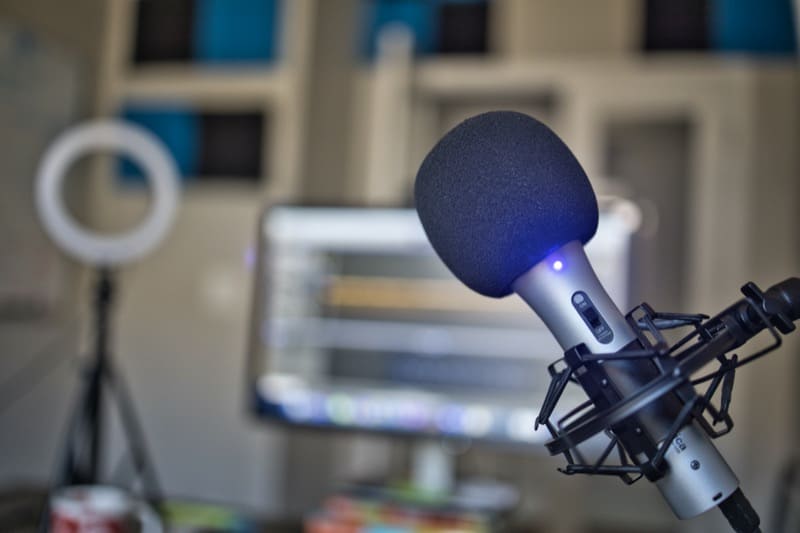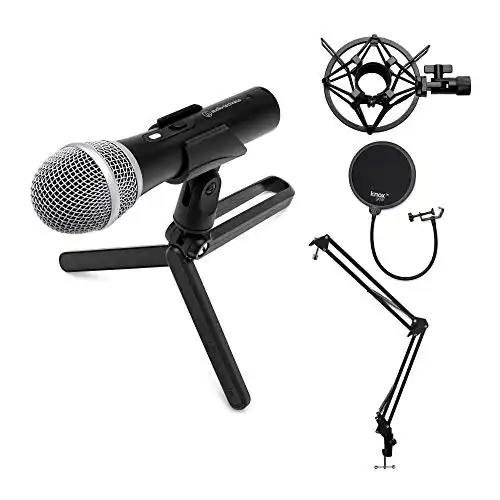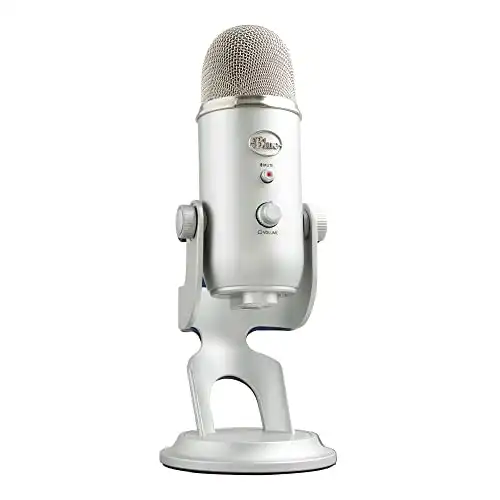If you’re in the sound world, you might be looking for a microphone. And if you’re starting, you likely don’t have a whole system set up in a recording studio, nor are you looking to over-invest in your equipment.
But don’t worry, here are two great microphones that are worth it: the Audio-Technica ATR2100x-USB Microphone and the

This is my mic, the
For a beginner mic, the 2100x is relatively cheap, produces professional sound quality with other attractive features. Honestly, it’s a fantastic mic even for pros and audio connoisseurs.
Below, we’ll look over their specs and dive into their differences and similarities. And we also researched product reviews on these two models for some first-hand experience!
Table of Contents
ATR 2100x-USB Microphone
Specs
The Audio-Tech ATR 2100x – USB Microphone looks like your traditional hand-held mic, sitting on a tripod desk stand.
This great entry-level microphone records produces professional-quality sound with USB and XLR outputs and is only cardioid dynamic (explained later). It comes with a desk stand so you can immobilize the mic and station it wherever you want.
The ATR2100x is 1.61 lbs in weight with dimensions of 10’ x 7’ x 3’ and runs on USB cord power. It’s also got a headphone output jack with level control and a built-in analog-digital converter. So you can monitor the audio coming out of the mic.
The 2100x gets sold with accessories:
- stand clamp
- tripod desk stand
- mini USB cable
- XLRF-Type to XLRM-type cable.
The 2100x is relatively cheap for a beginner mic and produces professional sound quality with other attractive features.
The Blue Yeti USB Microphone
Specs
As the name suggests, the
The
- a tri-capsule array for multiple polar pattern selections (cardioid, bidirectional, omnidirectional & stereo) with gain control
- a mute button
- headphone output
If you need to interview multiple people with one mic, then the Yeti has versatile settings to do it.
The
This model can be more expensive. Comparatively, the price is proportional to the extra features you are getting with the multiple mic settings depending on what and how you’re recording.
Differences
That was a lot of technical wording in describing the two microphones. Let’s explain further and break down their differences.
Design
Unlike the 2100x, you can’t hold the
The
The
Functionality
The
Perhaps the most significant difference between the
Condenser mics are best at capturing delicate and multiple tones. A condenser is more sensitive and made to obtain all sounds within the room. On the other hand, a dynamic mic is specific to one focused sound being fed directly into the mic. It is less sensitive to details and sounds around.
The polar patterns of the 2100x and
- The stereo pattern optimizes recording one voice and a few instruments.
- The cardioid function can is used for a single voice facing the mic.
- A bi-directional pattern records two people sitting face-to-face on opposite sides of the mic.
- The omnidirectional pattern picks up noise and audio being picked up by the mic from every direction.
On the other hand, the dynamic cardioid pattern of the 2100x optimizes audio being fed into the mic directly from the front. The 2100x is limited to the single design of the cardioid, maximizing one speaker.
While the condenser feature of the
The
Similarities between the ATR2100 and Yeti
There aren’t too many similarities between the ATR 2100x and the
The two microphones come with their own stands, so you don’t have to make additional purchases to begin your podcast.
The two microphones have headphone jack features, so you can plug in your headphones to hear your sound and the quality of what’s recorded. This allows the speaker to adjust their audio input (distance from the mic, the volume of voice, etc.) as needed.
The 2100x and the
Pros and Cons of ATR2100x
Pros
- Portability – Small size and weight
- Hand-held – some speakers prefer holding their mic to be closer. Others like to pace while they speak.
- Lightweight – Easier for travel purposes
- Simple usability – Single function with high quality
- Optimized for one-directional sound input
- Plugs directly into a computer
- Plugs straight into mobiles and tablets
- Plug-in power
- Headphone Jack – You can hear yourself being recorded
- Cardioid pattern reduces background noise
Cons
- Limited to dynamic cardioid polar pattern
- The stand is very cheap in quality
- Sound input isn’t as sensitive. If you are too far, you might lose some content.
- The on/off switch is heavy and can cause loud sounds in audio recording.
- You can’t share this mic between multiple people.
Pros and Cons of the Yeti
Pros
- Portability
- Versatility: Multiple polar patterns perfect for almost any setting
- Adjustable sound-input sensitivity (gain control)
- Adjustable headphone volume
- Mute Button
- USB connection
- Share the mic between you and at least one other speaker
Cons
- Heavier to carry
- No hand-held option
- Design flaw: when the mic is tilted toward a direction, the cord gets caught and is bent (possible damage)
- Requires batteries
- No XLR – can’t use it with XLR devices.
- Can be too sensitive in picking up other noises
- Users have reported that the mini USB cable isn’t great.
What Makes The ATR2100 Suitable For Podcasting?
The
The Audio Technica
Finally, the
Who Should Use The ATR2100x?
The ATR2100x is perfect for podcasters recording a single voice with no background audio requirements. Its simple cardioid polar pattern allows for the new podcaster with little editing experience to begin a professional-quality sounding podcast.
Inspiration can hit you at any time. You might be on the go and want to record a small clip. The 2100x accommodates this because of its lightweight portability and compatibility with mobile and tablet devices. A new podcaster without a specified recording room/studio can benefit from the portability and easy setup of the 2100x.
For podcasters whose interviews occur online and need only one microphone, this is the perfect mic for you. The simplicity of the 2100x is all you need. Because of its cardioid pattern and natural background noise reduction functions, the 2100x will reduce or not pick up computer noises as you likely need to be close to your computer for online interviews.
This mic is also perfect for solo vocalists and gamers who can fix the microphone close to their faces for pure vocal input while reducing background noise.
Who Should Use The Blue Yeti ?
The condenser mic and multipolar patterns of the
Due to its more substantial and sensitive nature, the
User experience
Audio-Technica’s
User reviews indicate that there are pros and cons to both mics. Namely, the
The Yeti, on the other hand, is known for having fantastic voice clarity but can sometimes pick up every keystroke if you’re typing nearby. According to users, if you have a computer fan or constant noise Yeti could pick it up. It’s important to know that, out of its three internal mic capsules, only one is active in cardioid mode, which can mean some wasted value.
Final Thoughts
If you’re just beginning, these are great microphones to start with. Choose the mic that will support your long-term trajectory, and consider your supporting devices and recording systems.
Depending on your purposes and situations, either of these mics will produce quality recordings that both novice and master podcasters use.
Further Reading from the manufacturers: Blue Yeti and AT2100x

